Key takeaways:
- Africa-Europe science collaboration thrives on knowledge exchange, blending local insight and technical expertise for innovative solutions.
- Effective communication and cultural awareness are essential for overcoming misunderstandings and building trust in partnerships.
- Regular evaluation of partnership dynamics and open feedback loops can strengthen relationships and improve future collaborations.

Understanding Africa-Europe Science Collaboration
Africa-Europe science collaboration is a unique relationship that thrives on the exchange of knowledge and resources. I remember my initial encounters with researchers from Europe who brought a fresh perspective to local challenges. It was exciting to see how their innovative approaches inspired our teams to think outside the box.
At times, I wonder how much we can achieve together when we truly understand each other’s strengths. For instance, during a joint project on climate change, it became clear that African researchers had a deep understanding of local ecosystems, while European scientists contributed advanced analytical tools. This blend of local insight and technical expertise illuminated the path forward, creating solutions that neither region could have developed alone.
However, I have seen firsthand how cultural differences can complicate these collaborations. I once participated in a project where misunderstandings arose from differing communication styles. It taught me that fostering mutual respect and clear dialogue in partnerships is not just beneficial; it’s essential. How can we build stronger connections in this diverse landscape? By appreciating what each partner brings to the table, we can craft science collaborations that are not only fruitful but also transformative.

Key Challenges in Partnerships
Partnerships often face the challenge of differing priorities among stakeholders, which can lead to misaligned goals. I’ve experienced moments where project timelines didn’t sync, creating frustration for everyone involved. How do we align our objectives to ensure cohesion in our efforts? I believe consistent communication and flexibility in adapting our plans can make a world of difference.
Another significant hurdle is resource disparity, which I witnessed during a funding application process. While collaborating with European institutions, I was struck by how their funding structures were often more robust than those in African countries. This imbalance can lead to feelings of inadequacy and hinder progress. It’s a reminder that equity in partnerships isn’t just important; it’s fundamental to sustainable collaboration.
Finally, trust can take time to develop, yet it’s crucial for effective partnerships. I remember a project where initial skepticism lingered among team members, stemming from past experiences that had left wounds. To overcome this, we dedicated time to team-building activities. This personal investment transformed our dynamics, fostering a sense of shared purpose. So, how can we cultivate trust from the outset? I believe transparency and patience are key; partnerships built on trust can weather even the toughest storms.
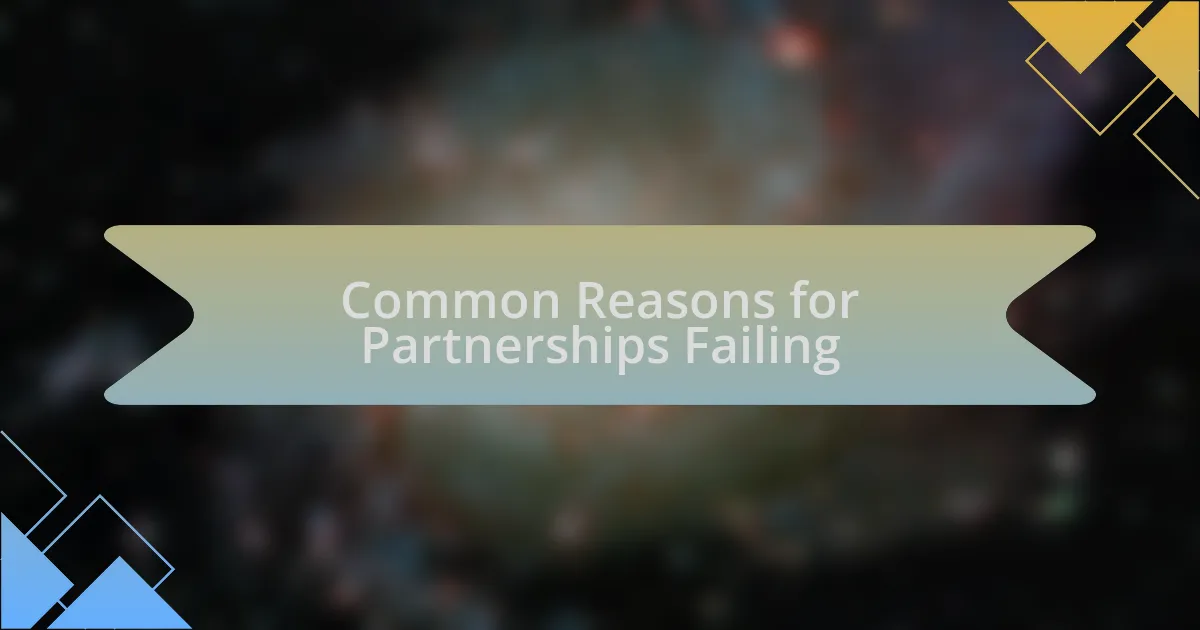
Common Reasons for Partnerships Failing
Miscommunication is a pervasive issue in partnerships, often leading to misunderstandings that can derail projects. I recall a situation where a lack of clarity about roles resulted in duplicated efforts, wasting precious resources and raising tensions. How can we ensure that everyone is on the same page? Regular check-ins and clear documentation can significantly lessen this risk.
Another common reason partnerships struggle is cultural differences. I’ve seen firsthand how varying approaches to conflict resolution can create friction. During a joint venture meeting, different perceptions of assertiveness clashed, leading to an uncomfortable atmosphere that stifled creativity. How can we bridge these cultural gaps? Embracing cultural awareness training has been a game-changer for my teams, encouraging empathy and understanding.
Finally, the lack of a shared vision can cause partnerships to unravel quickly. I remember working on a collaborative project where each institution had a distinct interpretation of success. This disconnect not only caused frustration but also undermined our collective impact. How do we cultivate a unified vision? I’ve discovered that co-creating objectives at the start fosters commitment and aligns everyone towards common goals. Taking this step early can prevent fragmentation down the line.
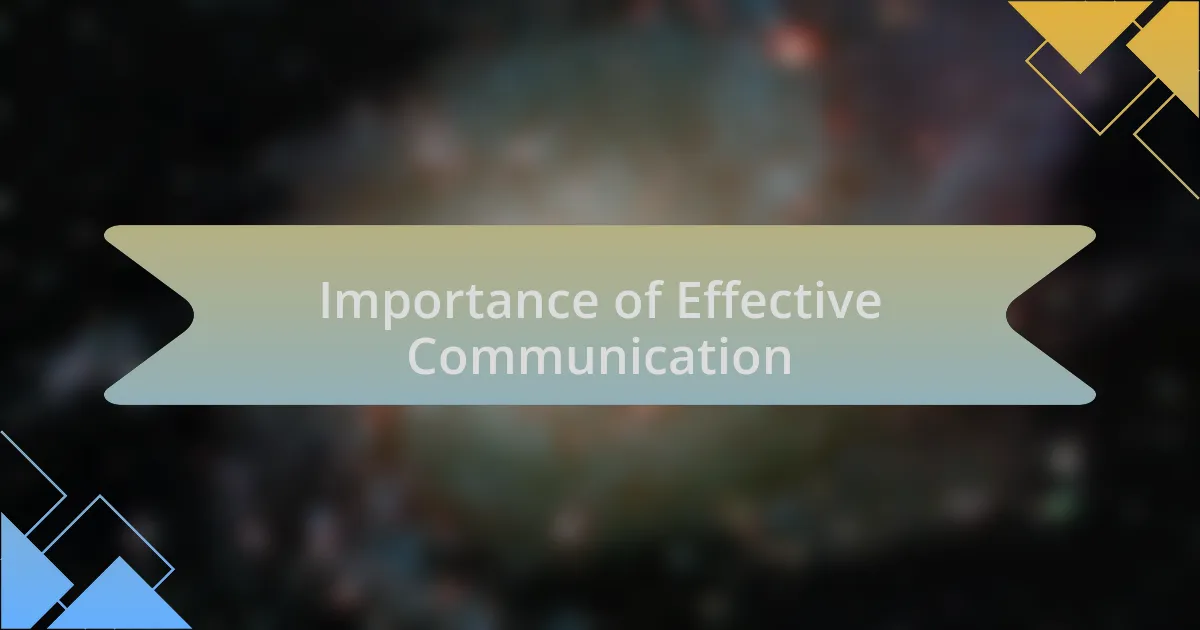
Importance of Effective Communication
Effective communication is the backbone of any successful partnership. I remember a project where my team struggled because we hadn’t established a consistent method for sharing updates. The frustration was palpable as deadlines approached, and I often found myself asking, “Why didn’t I know about this earlier?” This experience taught me that even simple tools, like project management software or shared calendars, can greatly enhance transparency and ensure everyone feels informed.
I can’t stress enough how crucial it is to create an environment where team members feel comfortable expressing concerns. In one instance, I noticed a colleague hesitating to voice their opinion during discussions, fearing it might lead to conflict. This silence not only robbed us of valuable insights but also created an undercurrent of tension. I learned that encouraging open dialogue through regular feedback sessions can empower individuals to voice their thoughts without hesitation.
Moreover, I’ve found that active listening can transform the dynamics of a partnership. When I started genuinely focusing on what my colleagues were saying, rather than just preparing my next response, I noticed a shift in collaboration. One time, after truly hearing out a teammate’s hesitations, we adjusted our approach significantly, leading to a breakthrough. Isn’t it amazing how investing the time to listen can turn potential miscommunication into a powerful catalyst for innovation?
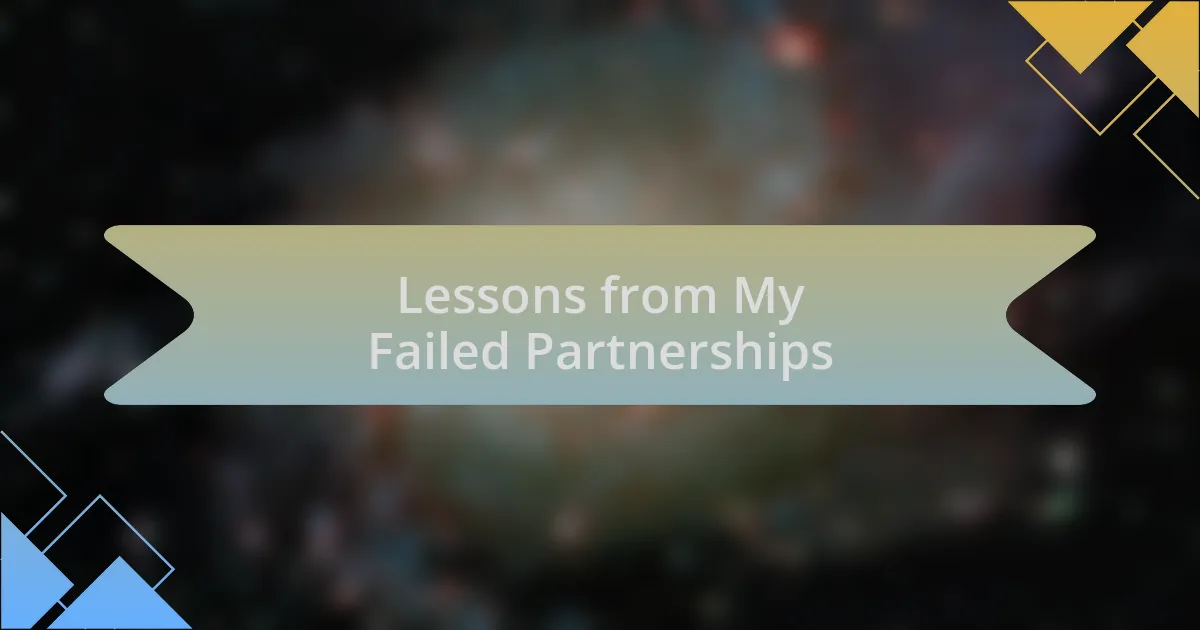
Lessons from My Failed Partnerships
Reflecting on past partnerships, one glaring lesson stands out: the power of aligning goals. In one initiative, my enthusiasm blinded me to my partner’s different priorities. We ultimately wasted months on a project that neither of us was passionate about. Looking back, I often wonder, “What if we had taken time to clarify our visions upfront?” It’s a stark reminder that shared objectives are vital to ensuring everyone’s investment in the partnership.
Another critical takeaway revolves around trust. I had a partnership where a lack of trust led to micromanagement instead of collaboration. It created an atmosphere where creativity drowned in fear of judgment. I vividly recall a day when I was so stressed about meeting expectations that I nearly gave up! From that experience, I learned that cultivating a foundation of mutual trust can foster a more productive and innovative workspace. How can we expect our teams to thrive if they don’t feel safe to explore ideas?
Lastly, the importance of adaptability cannot be overstated. Once, I partnered with an organization that was rigid in its procedures, unwilling to pivot when circumstances changed. This inflexibility ultimately caused our project to falter. It was a tough emotional ride, feeling as though we were fighting an uphill battle for relevance. Through this, I realized that being open to change is crucial for sustaining partnerships. After all, in a world that is constantly evolving, isn’t it essential for collaborations to do the same?
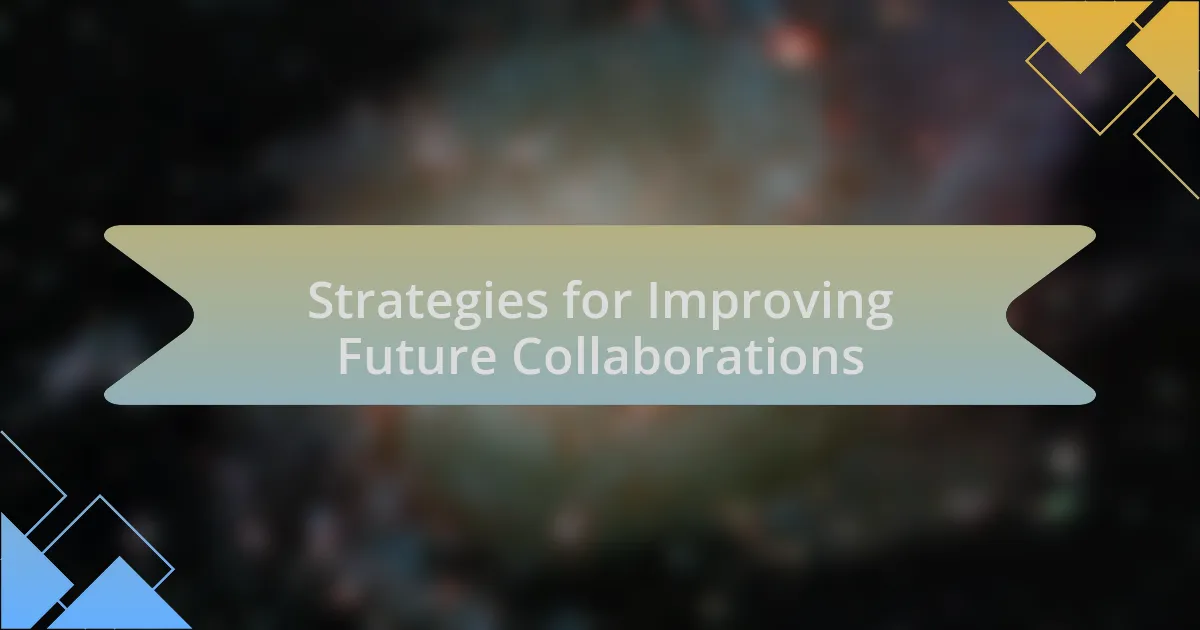
Strategies for Improving Future Collaborations
When it comes to enhancing future collaborations, one key strategy is the establishment of transparent communication channels. I recall a project where my team relied heavily on emails, leading to misunderstandings that snowballed into major setbacks. If only we had established regular check-ins or face-to-face discussions, I believe we could have resolved issues more swiftly and effectively. Why is it that we often overlook the simplest practices that can facilitate connectivity?
Another approach I find invaluable is fostering a culture of inclusivity. I once worked with a diverse group where not everyone felt comfortable sharing their ideas. Despite their brilliance, some voices remained unheard. I learned that actively encouraging participation not only empowers individuals but also leads to richer, more innovative outcomes. Have you ever considered how many great ideas go unshared simply because of a lack of confidence in the environment?
Lastly, I advocate for leveraging feedback loops. In one partnership, we didn’t regularly solicit input from one another, which led to a misalignment of expectations. Looking back, I wish we had aimed for continuous improvement through candid feedback sessions. Isn’t it fascinating how a simple conversation can unearth potential obstacles before they escalate? Engaging in these discussions creates a pathway for growth and ensures that each partner’s perspective is valued and integrated into the collaboration’s evolution.
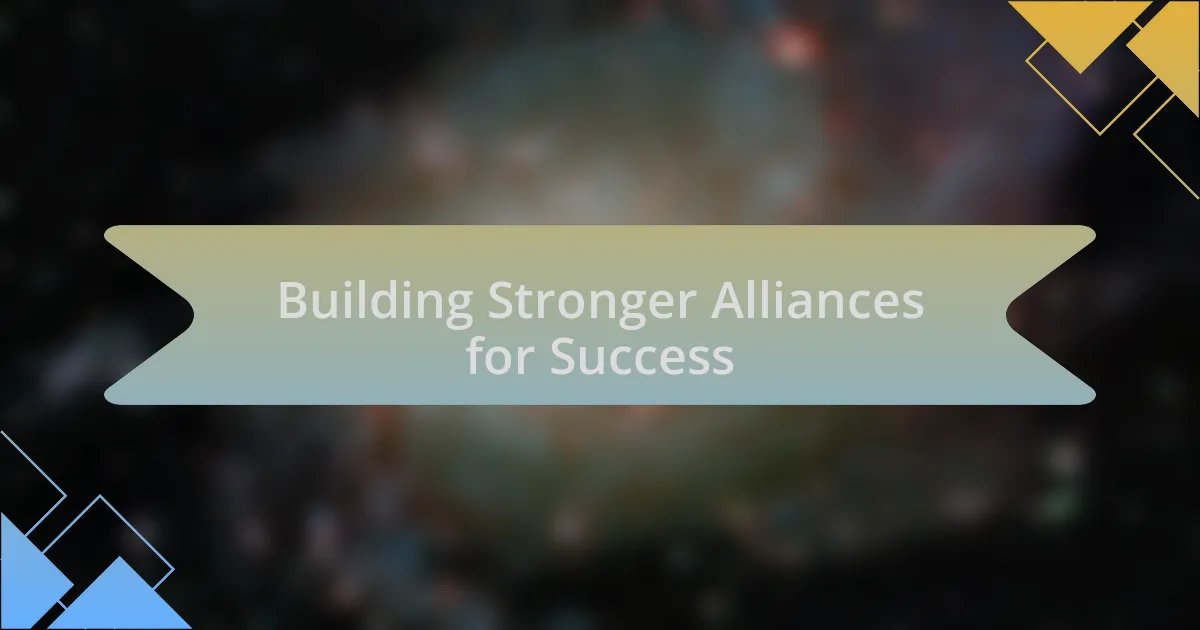
Building Stronger Alliances for Success
Building stronger alliances is often rooted in the realization that trust must be cultivated over time. I remember a collaboration in which we moved forward without establishing strong interpersonal relationships. Initially, we were excited and ambitious, but over time, the lack of trust became painfully apparent. Have you ever found yourself questioning a partner’s commitment due to not knowing them well enough? Authentic connections pave the way for transparency, which is essential in any collaborative effort.
Another critical aspect is aligning goals and values with partners from the beginning. During one project, we jumped into the nitty-gritty without discussing what success looked like for each party involved. It was frustrating to discover halfway through that we were pulling in different directions. Engaging in honest discussions about our motivations and measuring success differently could have saved countless hours of work. Isn’t it remarkable how shared objectives create a cohesive sense of purpose and direction?
Finally, regular evaluation of the partnership’s dynamics can be a game-changer. After a particularly challenging project, my team and I took a step back to assess what went wrong. It was enlightening to realize that we hadn’t taken the time to check in on each other’s well-being or the potential friction points in collaboration. Reflecting on these aspects can be transformative—what if we made this a regular practice? Acknowledging the human side of partnerships not only strengthens connections but also enhances resilience against future challenges.